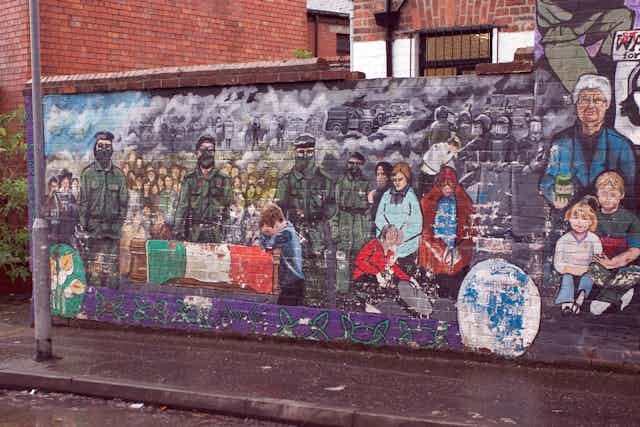It has been revealed that the Provisional IRA – the paramilitary group that fought for Northern Ireland to become separate from the UK – still exists, despite the IRA agreeing to disband in 2005.
An independent review, submitted to the British government, found the Provisional IRA and its leading decision-making body, the army council, continue to operate, albeit in a “much reduced form”. It concludes that they are not a security threat, but that the army council oversees both the Provisional IRA and Sinn Fein with an overarching political strategy.
This announcement follows a break-down in the Northern Irish political system. Unionist officials have resigned from their posts partly in response to allegations that Provisional IRA members were responsible for the murder of Kevin McGuigan.
While the findings may seem contradictory to the goals of long-term peace-building in Northern Ireland, it is important to put them in context.
It won’t be news to many people that the Provisional IRA and other paramilitary organisations still exist in some form in Northern Ireland. My own research in 2013 showed loyalist paramilitary organisations still recruit young people in areas of Belfast. Local leaders representing the main groups – the Provisional IRA, the Irish National Liberation Army, the Ulster Defence Association and so on – were found to be meeting on a regular basis.
In terms of conflict transformation and peacebuilding, maintaining these organisational structures has played a positive role in peacebuilding, which should be recognised.
The following points are made in full awareness that a continued paramilitary presence is neither ideal in a democracy nor for the victims of the Troubles. Maintaining networks of this kind can be detrimental to the peace process, with issues of criminality being notable. But it can also play a positive role in peacebuilding. It is important to recognise this to not make pressures for change which are counterproductive to overcoming the political stalemate in Northern Ireland.
When peace was agreed in 1998, the Provisional IRA’s membership was by and large integrated into Sinn Fein – the political party that now partially governs Northern Ireland.
However, in addition to a political route, former combatants also gravitated toward grassroots work, through prisoner advocacy groups and community peacebuilding groups. These consisted of former combatants and many still identify each other with their respective former organisations. Resources are mobilised through the old networks and command structures, albeit informally.
Maintaining command structures has enabled a cross-community network of paramilitaries to respond to violence at interface areas in Northern Ireland. Local leaders can call upon members to step in to prevent violence from escalating. This has been particularly important in cases where the police have difficulty in engaging with communities. One former Provisional IRA member commented on such an occassion:
What would have happened is the police would call and say ‘listen we are a bit stressed. Can you go up, there’s a riot taking place’. We’d go up and there’s two jeeps sitting there, and the police sitting in the jeeps saying ‘we can’t get out of the jeeps for security reasons, we don’t have the riot gear on’. And we’d say ‘hang on, are you kidding me’. So we’d have to go in and say ‘hang on you are not doing it on these people’s behalf’ or have a wee discussion why they shouldn’t be doing it. So on both sides [Republican and Loyalist] you’d have to intervene.
The former combatant networks expanded to include regular meetings between representatives of the key Belfast organisations. These meetings were crucial in dispelling rumours of imminent attacks on Orange Order parades by the INLA and by building resilience to dissident attacks. By maintaining these lines of dialogue and a command structure, leaders could return to their own groups to prevent retaliatory violence. If both sides could agree that further violence was not the solution to a given problem, they would return to their respective communities to discourage retaliation.
One interviewee present at meetings of senior paramilitary figures in Belfast revealed how talks like these played a vital role in calming tensions between republicans and loyalists when the army barracks was attacked in 2009. Such meetings were crucial for building trust, and the group leaders then went back to their own communities and kept a lid on any possible counter-attacks.
More recently, former combatant networks have played an active role in discouraging violence within schools in Northern Ireland and have functioned as a means to build trust between young people and the police.

Such important interventions would not have been possible without maintaining a command structure at an informal level. There is even a strong argument to be made that once conflicts end it is almost inevitable that networks will continue to exist. This is because loyalties build up between members during the conflict that are difficult to break and they have an incentive to stick together – a key strength of the Northern Irish peace process is it provided a route for these networks into peacebuilding.
The maintenance of command structures among the paramilitaries, including the Provisional IRA, has been one factor by which former combatants have contributed to peacebuilding. There is a fair-minded argument that such transitional mechanisms are no longer required, although it is still important to see command structures as an opportunity for peace, and not just a risk to be removed.

